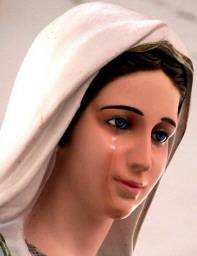The trial of a former church custodian accused of faking an incident in which a statue of the Virgin Mary wept tears of blood began in the northern city of Forli' on Friday.
Police say Vincenzo Di Costanzo dripped his own blood onto the face of the statue in the city's Santa Lucia Church in an attempt to simulate a miracle in March 2006.
Forensic experts who examined the 'teardrops' found they contained DNA matching that of a saliva swab taken from Di Costanzo.
''This is a case of high sacrilege,'' said public prosecutor Alessandro Mancini.
The ex-custodian claims he is innocent of all charges.
A group of elderly lady worshippers were the first to notice that red tear-like drops had appeared on the face of the Madonna two years ago and people flocked to the church to witness the event.
The news of a possible miracle was reported to the local bishop who immediately removed the figure, replacing it with a similar one, and called the police.
The 1.2-metre-high statue of the Madonna looking up to heaven, her hands drawn together in prayer, did not weep again after being moved to the bishop's offices.
The number of reported cases of Madonna statues moving or weeping has grown in recent years and the Vatican has become extremely cautious about giving its seal of approval.
One case which caused a commotion in the Italian Church revolved around a Madonna statue which started weeping tears of blood in 1995.
The 43-cm-high statue belonged to a family who had placed it in the garden of their home in Civitavecchia, north of Rome.
Reports that it was weeping attracted a whirlwind of media attention and thousands of visitors eager to see the miraculous statue. Excitement rose to a peak when the local bishop said he too had seen it cry tears of blood.
The blood on the statue was later found to be male but the owner of the statue, Fabio Gregori, refused to take a DNA test.
The Vatican subsequently avoided making any pronouncement on the authenticity of the plaster Virgin's tears.
In the wake of the Madonna of Civitavecchia, dozens of statues were reported to be weeping all over the country.
Practically all were shown to be copycat cases of people splashing blood or red paint on the cheeks of statues or surreptitiously throwing water on their faces.
In 2005 the Catholic Church said that tears of blood found on a statue of Saint (Padre) Pio in the southern Italian town of Marsicovetere were not a miraculous act of God.
All this is a far cry from the 1950s when a 'weeping' Madonna in a Sicilian house was deemed a miracle. Pope John Paul II consecrated a shrine devoted to her in 1994.













